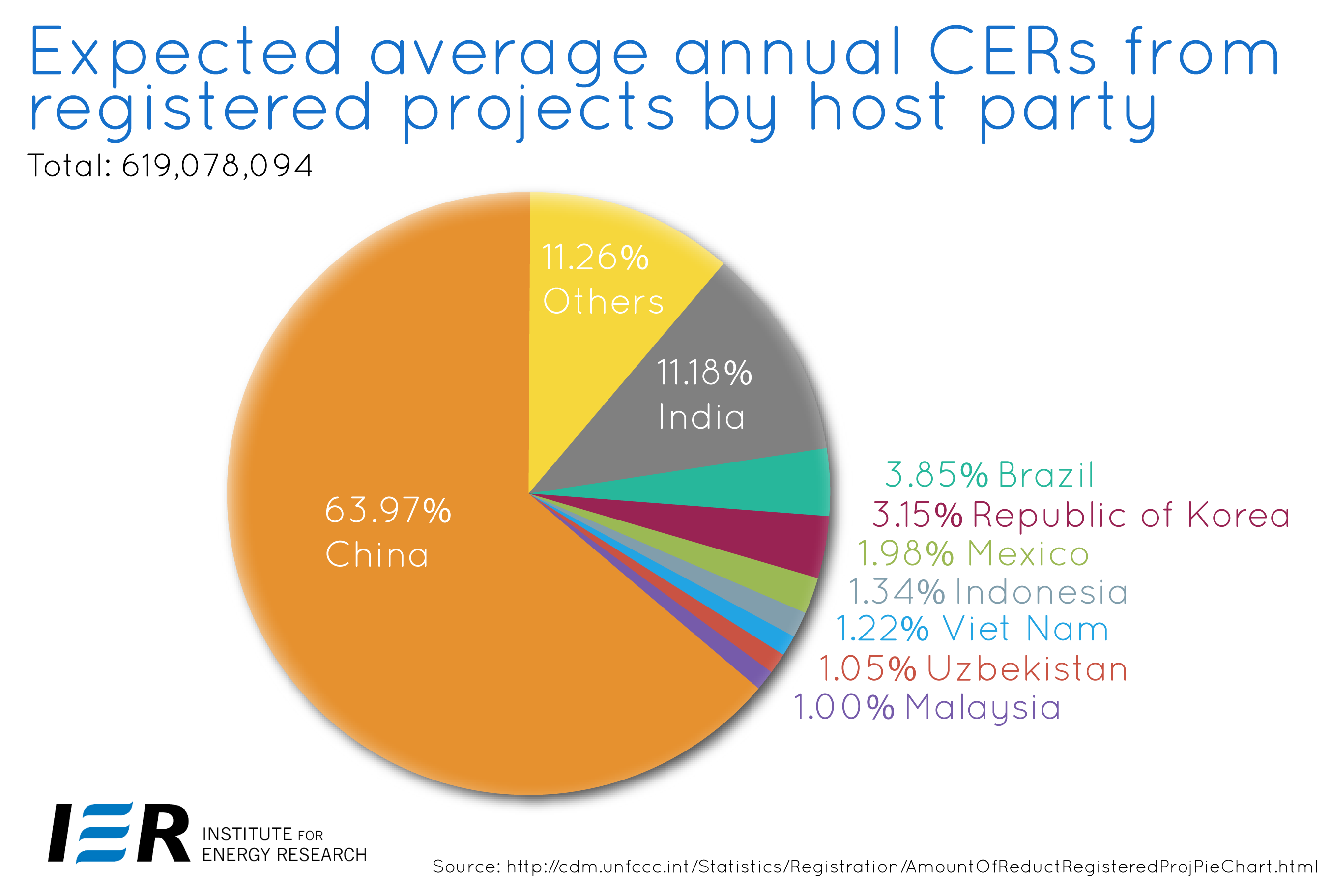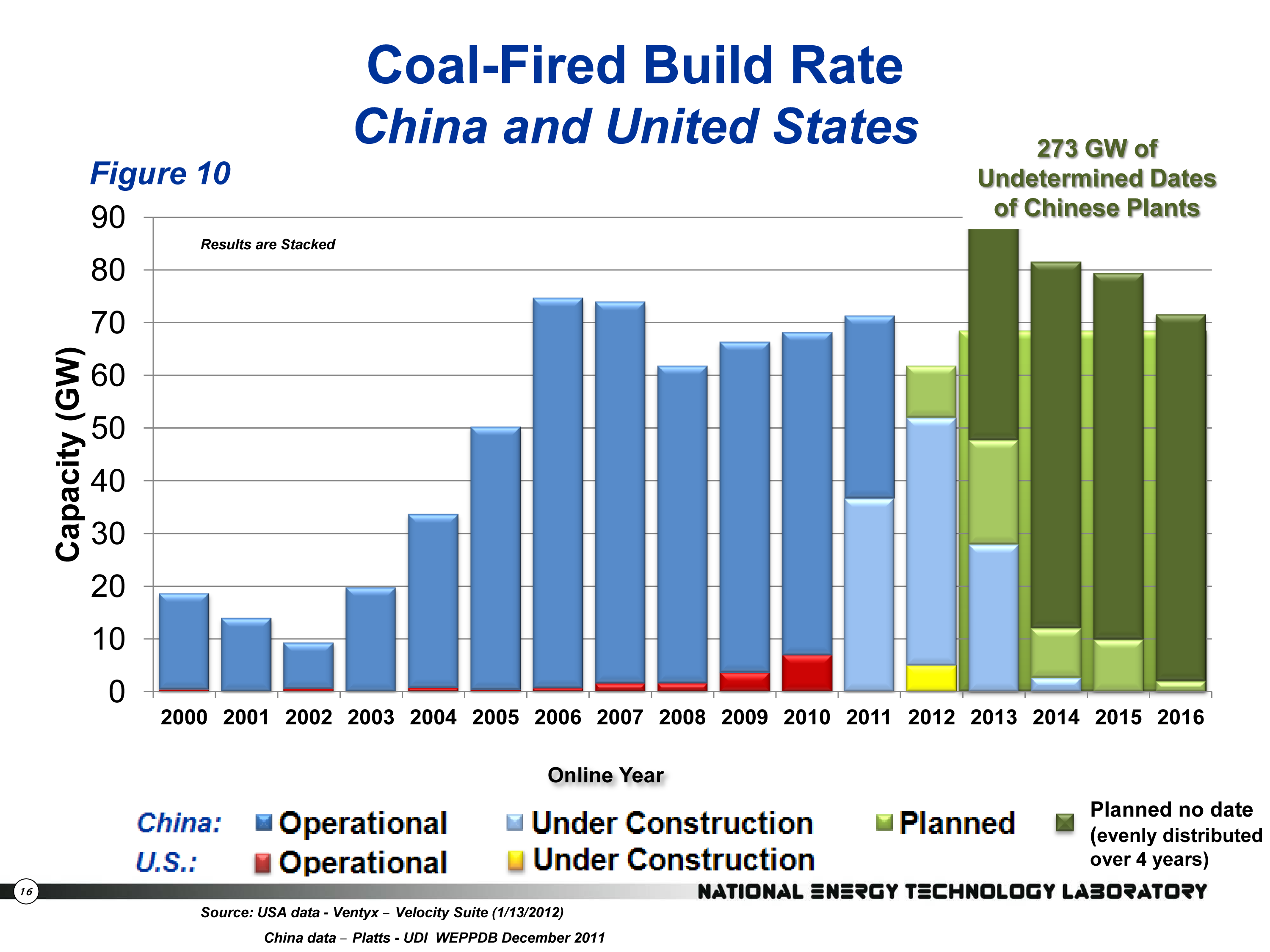What is the CDM? And, why is China benefiting from it? As a way to reduce greenhouse gas (GHG) emissions at lower cost, the creators of the Kyoto Protocol devised the Clean Development Mechanism (CDM). The CDM allows net GHG emissions to be reduced at a lower global cost by financing emissions reduction projects in developing countries where costs are lower than in industrialized countries. China has been the major beneficiary of the program, having received funding for projects that represent almost 64 percent of the registered Certified Emissions Reductions (CER), totalling 619,078,094 metric tons of carbon dioxide annually. These CDM projects will help China towards its goal of producing 15 percent of its energy from “clean energy” by 2020. However, the CDM designers are not getting the reductions they have paid for because many of China’s wind units are not connected to the electricity grid.
China’s CDM Experience
China has been benefiting from the CDM since the Kyoto Protocol came into force in 2005. Between 2005 and 2009, China received 35 percent of the 1800 CDM projects and 54 percent of the CERs. Now, China’s share of the CERs is higher at 63.97 percent. As recent as May of this year, China’s National Development and Reform Commission (NDRC) approved 57 wind power projects under the CDM directive. The country’s five major power companies accounted for 74 percent of the approved CDM projects.[i]
China not only benefits from wind projects under the CDM, but hydroelectric, solar and biomass power projects as well. Of the recent projects submitted for registration for China, the vast majority are wind projects, about 70 percent, with hydropower projects coming in second at almost 20 percent. However, about 30 percent of China’s wind units are not connected to the country’s electric grid.
As of the end of 2010, China led the world in installed wind capacity, with the United States a fairly close second. By the end of 2010, China had installed almost 45 gigawatts of wind turbines, while the United States had installed 40 gigawatts. The irony is that with 11 percent more wind capacity than the United States had in 2010, China produced only about half the amount of electricity from wind that the United States produced, according to the International Energy Agency. In 2010, China produced 50.1 billion kilowatt hours of wind powered electricity while the United States produced 94.65 billion kilowatt hours from wind energy.[ii] That lower amount of wind generated electricity for China is due to its transmission system not being able to handle the growth in wind capacity.
With so many of China’s “clean energy” projects covered by the CDM, it is not surprising that clean energy financing is led by China. China’s clean energy investment surged 92 percent in the second quarter to $18.3 billion, according to Bloomberg New Energy Finance. [iii] China has been the biggest market for wind turbines for several years and has recently quadrupled its goals for solar installations. The International Energy Agency expects China to overtake Europe as the world’s top renewable energy growth market this year due partially to Europe’s economic downturn and maturing renewable energy markets. The irony is, they’re being paid by the Europeans to do it.
China’s Electricity Approach
Unlike the United States, China is building coal generating plants and increasing its consumption of coal to fuel its growing economy, as many other developing countries are doing. According to China’s National Bureau of Statistics, China’s coal consumption increased 9.7 percent in 2011 to a record 3.7 billion tons, more than 3.5 times the coal consumption of the United States. China’s total energy use increased 7 percent, the fastest growth in 4 years to fuel an increase in its gross domestic product of 9.2 percent. China does not worry about using coal, and will most likely be importing U.S. coal as the Obama Administration continues to slowly make it disappear as a generating fuel in the United States.[iv]
The following chart compares the construction rate of coal-fired generating units in the United States and China. While coal-fired generating plants are almost non-existent in the future generating unit plans of the United States, coal-fired generating technologies are a major generating source for China. There are 273 gigawatts of coal-fired units that are planned in China beginning commercial operation within the next 5 years. Since China does not have the rigorous over-regulation and delays that have become part of the regulatory burden imposed by the Environmental Protection Agency in the United States, the country’s electric utilities are able to build coal plants relatively quickly.
Source: Department of Energy, National Energy technology Laboratory, Tracking New Coal-Fired Power plants, January 13, 2012, http://www.netl.doe.gov/coal/refshelf/ncp.pdf
Carbon Dioxide Emissions
According to the Energy Information Administration, the world emitted 31.78 billion metric tons of carbon dioxide emissions in 2010. China led the world with 8.32 billion metric tons (26 percent) of carbon dioxide emissions. The United States emitted 5.61 billion metric tons (18 percent) of carbon dioxide emissions in 2010. However, a recent study indicates that China’s carbon dioxide emissions could be nearly 20 percent higher.
A team of scientists from China, Britain and the United States, analyzed two sets of energy data from China’s National Bureau of Statistics: one set covering the energy use of the nation, the other of its provinces. The team identified a 1.4-billion metric ton emission gap in 2010 between the two data sets, which is slightly more than the annual emissions of Japan.
According to Chinese national statistics, carbon dioxide emissions have been growing 7.5 percent annually between 1997 and 2010, but, according to the study, aggregated emissions of all Chinese provinces have increased at 8.5 percent over the same period. The discrepancy in these statistics is mainly due to differences in reported coal consumption and processing at the provincial level.
According to Reuters:
Yang Fuqiang, a former Chinese energy official and senior adviser for the Natural Resources Defense Council in Beijing, said provinces routinely underestimate both their carbon emissions and their energy utilization rates.”I would say the biggest concern about the accuracy and reliability of (China’s emissions) data is coal – and that comes from too many small coal mines supplying small enterprises and industrial plants. They have no monitoring systems and generally speaking, they are also avoiding tax,” he said.[v]
Conclusion
China is clearly the world’s largest user of coal by far and the world’s largest emitter of carbon dioxide emissions and it has no intention of changing that direction since it needs to fuel its growing economy and supply electricity to its population, many of whom are still without power. While they publicly display concerns over carbon dioxide, their actions speak louder than their words and those actions include the greatest energy construction boom in history, led by coal. The country also intends to take advantage of payments for “clean energy” projects that are provided under the CDM whether or not it has the transmission capacity to utilize those projects. They clearly understand the importance of growing supplies of stable electricity to a modern economy that seeks to compete in the future. Meanwhile, the OECD countries continue to struggle internally about the value of affordable, abundant and reliable supplies of electricity.
[i] Utility Products, Fifty-seven wind power projects get regulatory approval in China, http://www.utilityproducts.com/news/2012/06/28/fifty-seven-wind-power-projects-get-regulatory-approval-in-china.html
[ii] International Energy Agency, IEA Wind 2010 Annual Report, July 2011, ISBN 0-9786383-5-2, www.iea.org
[iii]Reuters, China drives 24% rise in new clean tech investment, July 11, 2012, http://in.reuters.com/article/2012/07/11/clean-energy-investment-idINL6E8IB5JL20120711
[iv] Radio Free Asia, China’s Coal Use Soars, March 5, 2012, http://www.rfa.org/english/energy_watch/efficiency-targets-03052012104007.html
[v] Reuters, China emissions study suggest climate change could be faster than thought, June 10, 2012, http://www.reuters.com/article/2012/06/10/us-china-emissions-idUSBRE8590AD20120610





